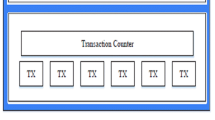Abstract
The land registry system is one of the very important revenue generator in any governance system that stores land ownership records. There are various issues and loopholes in the existing system that gives rise to corruption and disputes. The digitization of land records is not sufficient to prevent fraud, time delays, and brokers' involvement. Distributed Ledger Technology can be used to make this digitized record more secure and process it in a decentralized way, reducing paperwork in selling and buying of land. This paper presents a scalable and novel blockchain technology-based land/property registration architecture that utilizes a scalable trust based consensus mechanism, where all registry offices participate in improving the registration process. The framework integrates different state registry offices in the country. This article proposes a secure and efficient consensus mechanism compared to fewer message exchanges with the existing Proof-of-Work algorithm. Hence, this approach requires less time to append the block into the blockchain. Time required for message exchange per consensus is lesser by 59.01% than the PoW mechanism and takes 11% less time than the load-based approach.
















Similar content being viewed by others
Data availability
Data sharing not applicable. No new data were created or analyzed in this study. Data sharing is not applicable to this article.
References
Cocco L, Pinna A, Marchesi M (2017) Banking on blockchain: costs savings thanks to the blockchain technology. Future Internet 9(3):25
Invest (2020) Invest India Business Immunity Platform. Invest. https://www.investindia.gov.in.pdf
Kumar A, Yadav AS, Kushwaha DS (2020) Vchain: efficient blockchain based vehicular communication protocol. In: 2020 10th International conference on cloud computing, data science and engineering (confluence). IEEE, pp 762–768
Kumari A, Kushwaha DS (2011) Kerberos style authentication and authorization through ctes model for distributed systems. In: International conference on information processing. Springer, pp 457–462
Li D, Cai Z, Deng L, Yao X, Wang HH (2019) Information security model of block chain based on intrusion sensing in the IoT environment. Clust Comput 22(1):451–468
Mallick S, Kushwaha DS (2012) An efficient publishsubscribe protocol for collaborative content deliveryex-push. In: 2012 International symposium on cloud and services computing. IEEE, pp 152–156
Nakamoto S (2019) Bitcoin: a peer-to-peer electronic cash system. Manubot, Technical Report
Niranjana Murthy M, Nithya B, Jagannatha S (2019) Analysis of blockchain technology: pros, cons and swot. Clust Comput 22(6):14743–14757
Pippal SK, Kumari A, Kushwaha DS (2011) Ctes based secure approach for authentication and authorization of resource and service in clouds. In: 2011 2nd International conference on computer and communication technology (ICCCT-2011). IEEE, pp 444–449
Santander (2020) Santander launches the first real-time trades in Spain using we trade, a blockchain platform that helps companies go international. https://bit.ly/2Fw2pj7. Accessed 01 Oct 2020
Schwartz D, Youngs N, Britto A et al (2014) The ripple protocol consensus algorithm. Ripple Labs Inc White Paper 5(8):151
Singh N, Vardhan M (2018) Blockchain based e-stamp procurement system with efficient consensus mechanism and fast parallel search. J Mech Continua Math Sci pp. 0973–8975
Singh N, Vardhan M (2021) Multi-objective optimization of block size based on CPU power and network bandwidth for blockchain applications. In: Proceedings of the fourth international conference on microelectronics, computing and communication systems (pp. 69–78). Springer, Singapore
Singh K, Singh N, Kushwaha DS (2018) An interoperable and secure e-wallet architecture based on digital ledger technology using blockchain. In: 2018 International conference on computing, power and communication technologies (GUCON). IEEE, pp 165–169
Singh N, Kumar T, Vardhan M (2020) Blockchain based e-cheque clearing framework with trust based consensus mechanism. Cluster Comput, pp 1–15
Singh N, Vardhan M (2019a) Distributed ledger technology based property transaction system with support for IoT devices. Int J Cloud Appl Comput (IJCAC) 9(2):60–78
Singh N, Vardhan M (2019b) Blockchain based e-cheque clearing framework. Scalable Comput Pract Exp 20(3):511–526
Singh N, Vardhan M (2019c) Digital ledger technology based real estate transaction mechanism and its block size assessment. Int J Blockchains Cryptocurr 1(1):67–84
Singh N, Vardhan M (2020) Computing optimal block size for blockchain based applications with contradictory objectives. Procedia Comput Sci 171:1389–1398
Tseng L, Yao X, Otoum S, Aloqaily M, Jararweh Y (2020) Blockchain-based database in an iot environment: challenges, opportunities, and analysis. Clust Comput 23(3):2151–2165
Vujičić D, Jagodić D, Ranđić S (2018) Blockchain technology, bitcoin, and ethereum: a brief overview. In: 2018 17th International symposium Infoteh-Jahorina (Infoteh). IEEE, pp 1–6
Yadav AS, Kushwaha DS (2021) Digitization of land record through blockchain-based consensus algorithm. IETE Technical Review, pp 1–18
Yadav AS, Kushwaha DS (2021a) Blockchain-based digitization of land record through trust value-based consensus algorithm. In: Peer-to-Peer networking and applications, pp 1–19
Yadav A, Shikha S, Gupta S, Kushwaha D (2021a) The efficient consensus algorithm for land record management system. In: IOP Conference series: materials science and engineering, vol 1022, no 1. IOP Publishing, p 012090
Yadav AS, Agrawal S, Kushwaha DS (2021) Distributed ledger technology-based land transaction system with trusted nodes consensus mechanism. J King Saud Univ Comput Inf Sci
Yadav AS, Kushwaha DS (2021b) Query optimization in a blockchain-based land registry management system. Ingénierie Des Systèmes d Inf 26(1):13–21
Zheng Z, Xie S, Dai H, Chen X, Wang H (2017) An overview of blockchain technology: Architecture, consensus, and future trends. In: 2017 IEEE international congress on big data (Big Data congress). IEEE, pp 557–564
Funding
No funding available.
Author information
Authors and Affiliations
Contributions
All authors have equal contribution in this manuscript. All authors have read and agreed to the published version of the manuscript.
Corresponding author
Ethics declarations
Conflict of interest
The authors declare no conflict of interest.
Additional information
Publisher's Note
Springer Nature remains neutral with regard to jurisdictional claims in published maps and institutional affiliations.
Rights and permissions
About this article
Cite this article
Yadav, A.S., Singh, N. & Kushwaha, D.S. A scalable trust based consensus mechanism for secure and tamper free property transaction mechanism using DLT. Int J Syst Assur Eng Manag 13, 735–751 (2022). https://doi.org/10.1007/s13198-021-01335-0
Received:
Revised:
Accepted:
Published:
Issue Date:
DOI: https://doi.org/10.1007/s13198-021-01335-0




